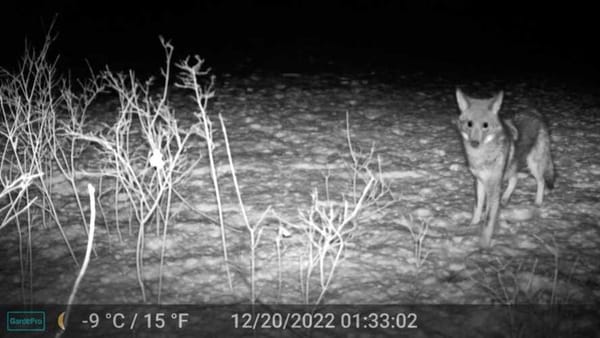It’s Coyote Mating Season, So Be Alert…And Yes, Be Awed
Those howls may be the love songs of the opportunistic eaters, but what if the coyotes are getting too close?

Those howls may be the love songs of the opportunistic eaters, but what if the coyotes are getting too close?

When a Marist College student was bitten by a coyote described as “aggressive” in early February, the incident made news not just up and down the Hudson River but way out west in San Antonio and Seattle — noteworthy because there are only a tiny handful of such encounters nationwide in any given year. By contrast, the coyote’s domestic cousins bite well over 600 people a year in New York State alone — and those are the ones we call our best friends.
Of the large predators in the Northeastern woods, the Eastern coyote has proven most adept at living among humans, even making the occasional Central Park appearance. ““As long as there are small strips of green space for them to make dens and reproduce out of sight, they're able to exist quite well,” says Michael Clark, wildlife biologist for the DEC’s Region 4, which covers Columbia County and points north and west. “We don't have estimates for its size, but I will say we have healthy coyote populations. There are, of course, different constituencies with different opinions about whether there are too many or not enough, which makes that whole question a moving target.”
Coyotes are winding up their mating season, which begins in January, over the next couple of weeks, meaning they’ve been more active and visible than usual. (Speaking of mating, Eastern coyote DNA reveals interbreeding with both dogs and wolves.). In late spring and early summer, they’re on the move again, gathering food for the pups. In populated areas, they’re more likely to conduct their business under cover of night, though you may catch a glimpse of one at dawn or dusk. In September or October, you may catch a glimpse of the less-cautious teens as they strike out on their own.
As with bears, problems can arise when coyotes learn to associate human habitation with easy meals. “They’re opportunistic eaters,” says Clark. “They’re omnivores, so along with smaller animals like squirrels, rabbits and cats, they’ll eat your trash, your compost, your birdfeeder or the cat food you put outside — in fact, that draws possums and skunks and foxes too. So you want to keep everything capped off, fenced in and cleaned up, and try to get the whole neighborhood on board.” That goes triple for anyone attempting to raise livestock — owners of poultry, sheep and goats are all too aware of how hard it can be to re-educate coyotes who’ve lost, as Clark puts it, “a little of that natural fear.”
Should you cross paths with a coyote, reinforce that natural fear: stand tall, wave your arms and yell at it, throw a stick or rock; it’ll run off. (If it continues to approach or acts disoriented, you may be witnessing the rare case of rabies. Back away and call 911 from safety.) Clark says he has no qualms about his kids, ages 4 and 7, playing in the woods near his rural Rensselaer County home.
Their knack for adapting to the margins of human settlement has made coyotes heroes and antiheroes of hundreds of indigenous tales, in which they commonly show up as tricksters, sometimes even as deities. And as many of us can attest, their yowls and yips add a touch of sonic drama to a peaceable evening.
Video of coyote pups courtesy Stacy Osur
“I saw a beautiful one just a couple of days ago,” says Stacy Osur. “There was snow on the ground and there it was, with a beautiful lush coat — I think it was a boy. Just strolling across the yard, all alone, at about two in the afternoon. I was surprised. But they’re definitely meeting up out there — the noise gets really intense around 11 every night.”
Osur found her spot in the Berkshires about two years ago now, with “considerable acreage” and lots of rocky, wooded hills she happily shares with, she estimates, at least 25 coyotes. “I think the previous owner had a large dog, so they stayed clear. My dog is small and indoors, so they’ve really made my woods their own.”
Last July, she got a rare treat. “Five puppies, running around just chasing their tails and rolling around. I have a gazebo and they were all over it. They chewed up the base of my solar light. They were there for two days, no mom in sight, so I think it was weaning time. They were adorable; I couldn’t stop watching them.”
When humans make a concerted effort to remove possible food sources, says Clark, coyotes will stay in the deeper woods like those surrounding Osur's place, where they’re dandy neighbors. “They stay way away from the house, at the other edge of a large mowed area,” says Osur. “And I never see them out hiking, because they hear me and stay away.”








